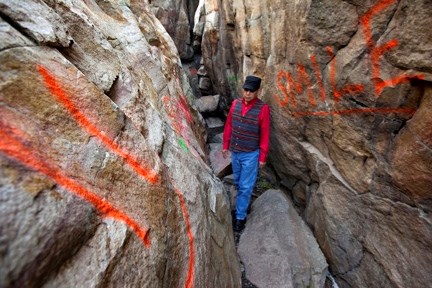The historic Big Rock, also known as the Okotoks Erratic has been vandalized yet again, this time with 31 tags.
It was first defaced eight weeks ago with black spray paint, and then vandals came back to add colour two weeks ago over the weekend, said Rick Green, head of planning with the Historic Sites and Museums Branch of the Government of Alberta. The words “ love,” “ smile,” and “ MR8 4 ever,” were painted on the rocks with the signature, “ #clanyolo.”
Cst. Robert Gallant with the Okotoks RCMP said they currently have no witnesses or suspects, but the investigation is ongoing. He said it is generally hard to prove acts like this because Big Rock is located in a secluded area. “ There are no tags that are identifiable,” Gallant said. “ We have a catalogue of tags that belong to certain people and none of them matched.” Green said there was a contractor who cleaned the site on Friday and didn ' t notice any damage. Then on Monday, two archaeologists were visiting the site and reported the acts of vandalism, he said.
“ Vandalism has been happening here for at least 10 years now,” Green said.
He said he has placed four incidence reports to the police since August. Green said it is hard to follow up when there are no suspects or witnesses, but he said the police would patrol the area more.
“ We aren ' t dealing with sophisticated graffiti artists, just a bunch of kids,” Green said.
Alireza Farrokhi, restoration officer with the Alberta government, said he will be bringing a team of three other people from Edmonton at the end of July to remove the graffiti. He said they will use a high pressure water spray system as well as hand brushes for the sensitive areas of the rock. It will take about a day or two to complete. He said that he has considered spraying the rock with a graffiti repellent coating, but there isn ' t enough information published about how it would affect and interact with the rock.
Big Rock is considered a sacred and historic landmark to many Albertans, but in particular First Nations.
The legend of Big Rock as told by the First Nations people goes that the great spirit Napi lent his jacket to the rock, but then the rock wouldn ' t give it back. The rock chased Napi away from the Rocky Mountains, so the spirit sent birds after the rock, which pecked it until it broke in half where it now lays 10 kilometres southwest of Okotoks.
Donna Crowshoe, from the Piikani Nation, said that there needs to be more education in schools to prevent random acts of vandalism. She said the history of Big Rock should be included in the school ' s curriculum from elementary school onwards. She encourages repetition to remind people, because if they just hear a story it may be forgotten, but she said that if it is included in the school ' s curriculum the history may be preserved.
Crowshoe also suggested having a large fence surrounding the rock or an information booth that is consistently manned with someone that can tell visitors about its meaning. Blair First Rider, Aboriginal consultation advisor with the Alberta government, suggested having controlled hours when the rock may be visited to stop vandals at night. He also said installing video cameras might be another option.
“ But the economies of the day will rule,” First Rider said.
The problem, said Jack Brink, curator at the Royal Alberta Museum, is that the town keeps encroaching closer to Big Rock, and when the number of people visiting the site increases, so do the odds that someone will vandalize it. Another issue is most of the vandalism was done in the crevice of one of the rocks, which means that people can spray paint out of sight, he said.
“ It ' s like going to church and defacing it with swear words,” Brink said.
Vandals will be fined $50,000 under the provincial Historical Resources Act, said Brink.




